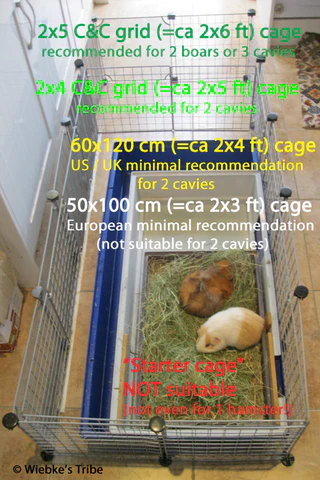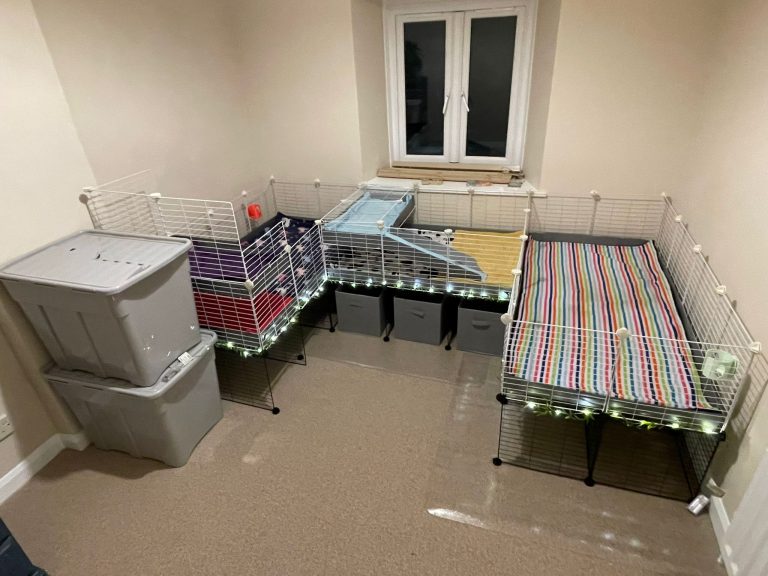Guinea pigs are wonderfully curious & love to see what is going on around them! Housing them indoors is a wonderful way to experience their full character making them part of the family.
As they are very active animals enclosure space is very important to allow them to run around and play. They are neither diurnal or nocturnal, but rather a little bit of both & only sleep 4-6 hours per 24 hours in short bursts rather than sleeping for one long period.
A pair of piggies should have at minimum 160x70cm ( 5′ 2″ x 2′ 3.5″) of ground floor space. Floor space needs to be smooth level surface, especially not wire as this can damage their feet. You you can have multi levels accessed via shallow ramps however this configuration may not be suitable for all situations; For example older guinea pigs who may have arthritis which can make negotiating ramps difficult. Ramps that are too steep or do not have a suitable grippy surface can also cause stress & injury.
They are sensitive to loud noises as they are a prey animal, so it’s best to keep them in areas where there is not likely to be lots of loud sudden noises (tv, speakers, etc).
Additionally, piggies need to be kept away from other unsupervised pets and children to prevent accidental injury and stress. Elevating them off the floor also helps with confidence & interaction, especially when settling into a new home.


C&C refers to ‘cubes and correx’. The cubes are grid panels constructed from powder-coated steel, usually in black or white. These grids click together to form the frame of the enclosure. Correx or ‘Choroplast’ is another name for corrugated plastic, which is used to form the base or ‘liner’ of the cage.
We & other established rescues advocate strongly for C&C enclosures for the following reasons:1) C&C CAGES ARE FLEXIBLE & AFFORDABLE
You can easily adjust your cage design by adding or removing single grid panels. There are no limits to what you can achieve once you get the hang of it! Expand your setup, create compartments or levels, add a lid or a stand or have it L-shaped to fit a certain space….the possibilities are endless with some creativity & inspiration. Compared to conventional cages or hutches, C&Cs can be built very affordably especially with some DIY skills. Pre-packaged kit setups from established suppliers are also available for a small premium.
2) C&C CAGES ARE EASY TO CLEAN
Because most C&C cages are open, without a lid, they’re very simple to clean. Using absorbent, washable fleece liners reduces mess & maintains hygiene. Having an open set up also makes it easier to interact with your piggies, helping you bond. Building your C&C with a stand makes it even easier to clean as well as creating useful storage space under the cage.
3) C&C CAGES ARE QUICK TO ASSEMBLE
Don’t worry – you don’t have to be a DIY expert to build your new C&C cage. In fact, it’s all pretty straightforward. Adding or removing grids is also easy. Correx liners can be ordered pre-cut from many suppliers. For custom setups, correx can be purchased in raw ‘sheets’ which can cut & scored with basic hand tools into various shapes/sizes.
4) C&C CAGES OFFER CHOICE & CREATIVITY
Several established C&C suppliers offer grids & liners in various colour combinations so you can accessorise & make the enclosure a feature in your home. Decorate your C&C cage to your taste.
5) GUINEA PIGS FEEL SAFER WHEN ELEVATED IN A C&C
You might think your guinea pigs would prefer to be closer to the ground but actually the opposite is true. By having your guinea pigs up at the same level as you, they’ll be much less skittish and will adjust to you being around them, strengthening your bond & helping your piggy adjust to their new living space more quickly. A stand also creates storage space under the cage – ideal for storing your piggies spare bedding & supplies!
It is also worth noting that most traditional cage manufacturers don’t share the internal measurements of their cages and that many traditional cages consist of plastic base parts which slant inwards on all four sides, taking away your pigs’ much needed living space. A tad misleading to buyers, don’t you think? With C&C cages on the other hand, what you see is what you get – a roomy, humane space for your deserving piggies.
Image source: https://www.theguineapigforum.co.uk/threads/cage-size-guide.120795/

Ready to try C&C? We sell our own affordable C&C setups for new starters or upgrades! Buy C&C


We no longer encourage the housing of guinea pigs outdoors full time, particularly in unsheltered hutches. Whilst we acknowledge that not everybody has the indoor space available, it can be difficult to buy purpose-built accommodation that provides adequate floor space. Not only is size an issue but also weatherproofing; most hutches found online or in pet shops are made out of cheap & thin materials that do not stand the test of time in our cold, wet British climate.
In our experience, piggies in outdoor hutches often lack interaction. Additionally, in the winter months the regular cleaning/feeding chores can become monotonous, particularly for children which can (and has!) escalated to neglect.
Adverse weather conditions aswell as fireworks or predator presence can cause stress & premature death. As a result of this, we do not normally rehome to fully outdoor hutches unless they are housed in a larger area like an / shed etc. Many people are now looking at alternative ‘hybrid’ accommodation setups as an alternative to to hutches for the above reasons.
Converting a shed, Wendy house or summerhouse into the perfect guinea pig paradise is getting more and more popular, as some people may already have one they can convert or they can be bought 2nd hand or even new for a similar price or even cheaper then hutches. A pair of piggies should have at minimum 160x70cm ( 5′ 2″ x 2′ 3.5″) of ground floor space available within this accommodation.
Not only do sheds or Wendy houses offer more room for your furry friends but they are also easy to insulate for the colder weather & last much longer than a hutch; as well as giving the owners the option to go inside making it easier to clean & interact with the guinea pigs. Runs can be easily attached to the side of a shed with access via a hole or tunnel for the summer months
If a hutch is intended to be used within a house, garage or outbuilding, the minimum size for a pair is approximately 150cm x 60cm (5’ x 2’), eg a ‘Pets At Home’ Bluebell 5′ or a Chartwell 5’. If utilising a double hutch, consideration should be given to ensuring that your piggies are physically capable of using the ramps (they may require training), especially as many supplied ramps are too steep or lack grip. Increasing the height of ramp sides can help. You can also add a barrier or banister on the top level.


Your guinea pigs will thrive both physically and mentally, if they have access to a large, protected, grass run when outside weather allows complete with comfy, floored hides. In the summer, the run should be placed in a shady area or be covered with a sunshade. Guinea pigs can die from heatstroke if they get too hot.
The run should be moved on to fresh grass every time it is going to be used. Always ensure that your accommodation is escape-proof in addition to being predator-proof!
Never leave your guinea pigs in a grass run overnight as foxes, rats or even pet dogs will dig underneath to get to them. The guinea pigs should be supervised when outside during the day if you have a particular problem with foxes, rats or curious dogs.
Your grass run should allow you easy access to your guinea pigs. This makes life much easier and less stressful for both you and your guinea pigs if you are able to easily collect them from the run after a hard days grazing!
Fleece – Now a very popular choice for indoors. Will need an absorbent layer underneath such as puppy pads or alternatively you can buy pre-made liners with this already sewn inside. Available in lots of colours so can look more aesthetically appealing. It does however require regular washing and time to try. Pet wash bags are a good idea to protect your machine and two sets of bedding so you can use one and wash one.
Shavings – if you wish to use shavings they must not only be dust free but be kiln dried in order to remove the harmful phenols that attribute to health issues in guinea pigs. This is more common in shavings designed for horses such as bedmax, littlemax, pureflake extra. They can however still be quite sharp on guinea pig feet. We would recommend using other alternatives such as Auboise or Megazorb if you wish to use a disposable bedding.
Shredded Paper – This often varies greatly in quality. It can be dusty and not everyone removes staples and other harmful things before shredding. Its also not particularly absorbent and can become very dirty and wet easily: We do not recommend this.
Hay & Newspaper – A thick bedding of hay on newspaper can also be used if you an access to adequate soft bedding hay. It ensures the guinea pigs have plenty of access to graze as they would naturally. It also has the added advantage of being very low maintenance to clean as you can just roll it up and dispose of it.
Regardless of what ‘substrate’ you use, good quality hay must be available at all times for eating as this constitutes 80% of their daily diet! Additionally, If your guinea pigs are outdoors always ensure abundant hay is also provided in the sleeping quarters for warmth.

The Little Wheekers is a Guinea Pig Rescue based in the Bristol area, helping to give piggies new loving homes.